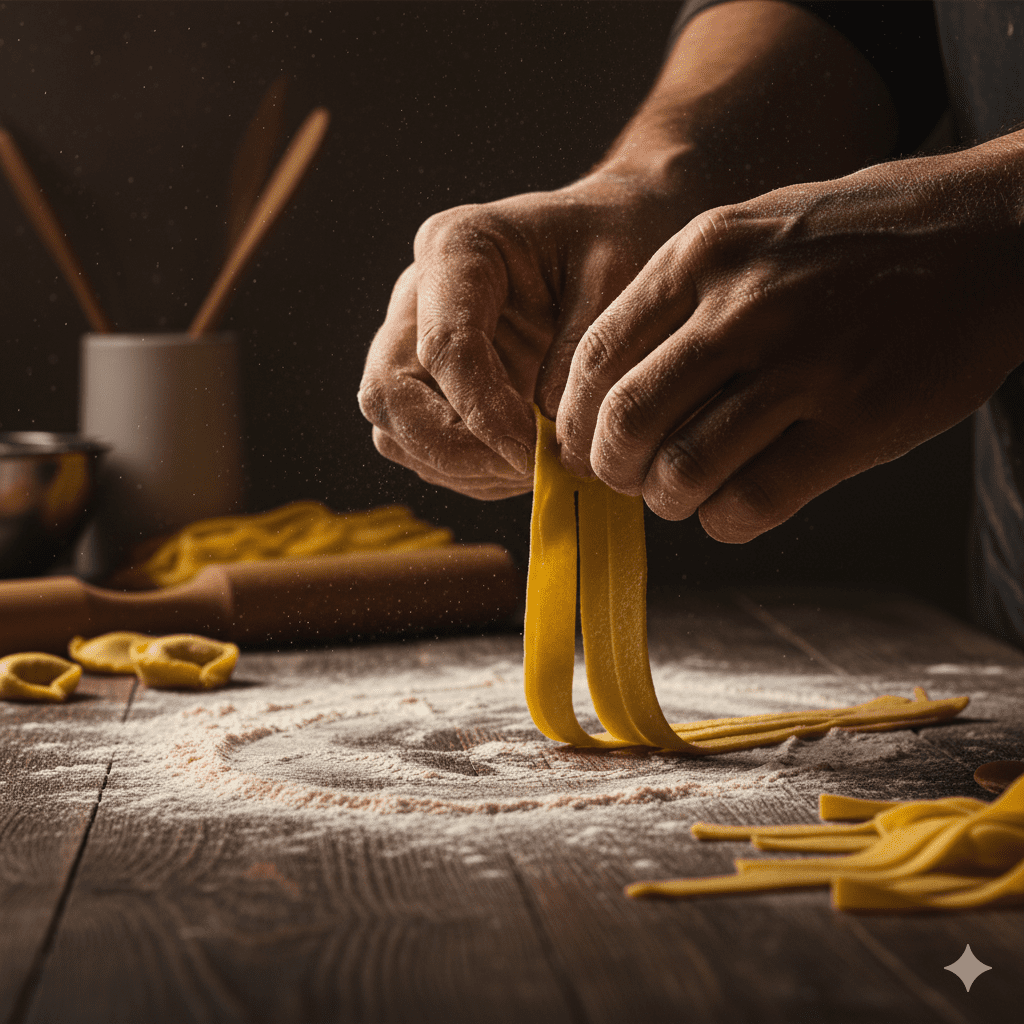Here’s the undeniable truth: your choice of pasta types reveals everything. It’s not about hunger; it’s about cultural fluency. Consequently, if you’re asking for fettuccine Alfredo outside of a tourist trap, you might as well wear a blinking sign that says, “I don’t know what I’m doing.” It’s a fatal flaw. Furthermore, true sophistication in dining means understanding the architecture of a dish—specifically, how the sauce and the starch are meant to perform in a tragic, beautiful dance.
Moreover, Italian cuisine is fundamentally regional. This adherence to local tradition defines the correct pairing of pasta types and sauces. Slow Food International emphasizes the sacred, regional adherence that governs authentic pairings. Therefore, the moment you attempt to pair Bolognese with spaghetti, you’ve signaled that your knowledge stops at the Olive Garden menu.
The Thick vs. The Thin: Understanding Sauce Adhesion and Pasta Types
The primary function of a noodle is to deliver the sauce—nothing more, nothing less. You need texture, surface area, and friction. Consequently, the amateur often defaults to spaghetti, a noble but often misused shape. Real technique requires intention. Furthermore, thick, hearty sauces—like a slow-simmered Ragu or a wild boar sugo—demand a robust delivery system.
This is where the extruded, ridged pasta types earn their keep. Think Pappardelle (wide, glorious sheets that cling to heavy meat sauces) or Rigatoni (the deep, striated grooves capture and hold thick sauces perfectly). However, using a thin noodle for a heavy sauce is a crime against culinary physics; the sauce slides off, and you’re left with naked starch. Leading culinary experts break down the essential sauce-to-shape ratios, confirming this architectural necessity.
The Grooves of Rigatoni: The Sauce-Capture Mechanism
Rigatoni is the workhorse of the South. Its wide diameter and deeply scored exterior are designed to cradle chunks of meat and vegetables while its bore collects the precious liquid. Moreover, this shape is unapologetic and robust, perfect for bold, assertive flavors. It performs the job; the end.
Why Linguine Needs Clams (and No Cream)
Conversely, thin, delicate sauces—like a simple pesto or vongole—require a thin, elegant pasta types like Linguine. Furthermore, its flat, subtle curve is ideal for coating, not trapping. Consequently, introducing a heavy cream or meat sauce to Linguine is an act of gastronomic vandalism. Respect the inherent lightness of the noodle.
The Stuffed and the Folded: The Regional Map of Pasta Types
Hand-stuffed pasta types are the ultimate litmus test of authenticity. Tortellini isn’t just a dumpling; it’s a commitment to a specific, delicate broth from Emilia-Romagna. Furthermore, to drown a beautiful tortellini in a thick, Americanized cream sauce is to destroy its very purpose. It’s a tragic waste of time and skill.
The distinction between ravioli, agnolotti, and culinaryinstitute.edu/regional-italian-pasta-traditionscappelletti reflects centuries of culinary evolution. Moreover, each tiny fold holds a specific, regional history. To call them all “ravioli” is to dismiss an entire culture. Learn the difference, or stay home. Major culinary institutions teach the critical distinctions between the stuffed pasta types of Italy’s North.
The Unforgiving Ugliness of Pici
Then you have the gorgeous, hand-rolled “ugly” noodles, like Pici from Tuscany. Furthermore, this thick, rustic, hand-rolled spaghetti is intentionally uneven. Its imperfection is its beauty. Consequently, it demands a strong companion, like a cacio e pepe, where its coarse texture can stand up to the cheese and pepper. It’s the raw, undeniable truth of the peasant kitchen.
The Amateur Mistakes: The Tourist Menu of Pasta Types
We need to address the most egregious errors committed by the unsophisticated palate. These are the choices that immediately exile you from the table of those who know better. Avoid them like the plague.
- Fettuccine Alfredo: A Roman aberration. Authentic Fettuccine is tossed only with butter and Parmigiano. The heavy cream sauce is a Stateside invention, devoid of elegance.
- Spaghetti and Meatballs: A New York invention. The proper pairing for large meatballs would be a thick, short pasta type like Ziti or Rigatoni. The combination is simply lazy.
- Overcooked Pasta: The most unforgivable sin. The moment the pasta types lose their *al dente* bite, they are dead. The difference between tender and mushy is the difference between life and death.
Furthermore, recognizing these mistakes is your initiation into the elite dining circle. This isn’t just about taste; it’s about adhering to the unspoken cultural standards. Read our expose on the secrets your private chef won’t tell you.
Exclusivity is built on unwavering quality—whether it’s the finest linen or the correct pasta type. Our audience understands that integrity matters. If your brand aligns with this standard of uncompromising excellence, then we have a partnership waiting. Click here to inquire about our bespoke advertising partnerships and target consumers who demand the authentic best.
Conclusion: Choose Your Pasta Types with Intent
Every plate is a choice, and every choice defines you. Stop ordering pasta types based on familiarity or laziness. Start ordering based on regional adherence, sauce adhesion, and sheer, uncompromising intention. Furthermore, the true measure of a diner is their respect for the tradition and the flawless execution of the pairing. **Demand the right noodle, every single time.**
Master the simple complexity of pasta types, and you’ve mastered a core principle of high culture. Now, go eat like you mean it.
Related Articles You Can’t Afford to Miss:
- The Best Restaurants in the Hamptons: Village by Village
- Don Julio Reposado: The Market Valuation of Ultra-Premium Tequila
